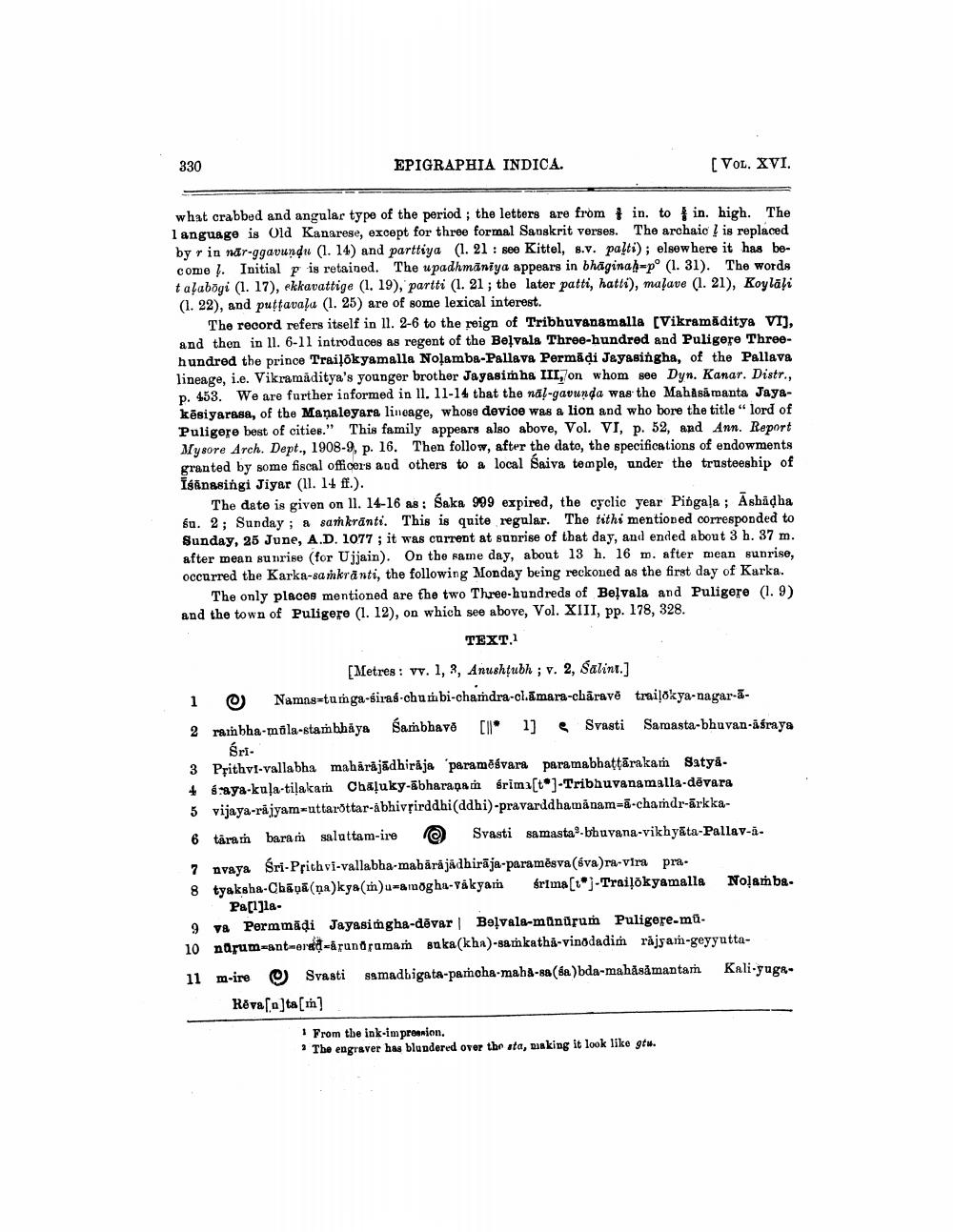________________
330
EPIGRAPHIA INDICA.
what crabbed and angular type of the period; the letters are from in. to in. high. The language is Old Kanarese, except for three formal Sanskrit verses. The archaic is replaced by r in nar-ggavundu (1. 14) and parttiya (1. 21: see Kittel, s.v. palti); elsewhere it has become. Initial p is retained. The upadhmaniya appears in bhaginah-p° (1. 31). The words talabogi (1. 17), ekkavattige (1. 19), partti (1. 21; the later patti, hatti), malave (1. 21), Koylali (1. 22), and puṭṭavala (1. 25) are of some lexical interest.
[VOL. XVI.
The record refers itself in 11. 2-6 to the reign of Tribhuvanamalla [Vikramaditya VI], and then in 11. 6-11 introduces as regent of the Belvala Three-hundred and Puligere Threehundred the prince Trailōkyamalla Nolamba-Pallava Permaḍi Jayasingha, of the Pallava lineage, i.e. Vikramaditya's younger brother Jayasimha III, on whom see Dyn. Kanar. Distr., p. 453. We are further informed in 11. 11-14 that the nal-gavunda was the Mahasamanta Jayakesiyarasa, of the Manaleyara lineage, whose device was a lion and who bore the title "lord of Puligere best of cities." This family appears also above, Vol. VI, p. 52, and Ann. Report Mysore Arch. Dept., 1908-9, p. 16. Then follow, after the dato, the specifications of endowments granted by some fiscal officers and others to a local Saiva temple, under the trusteeship of Isanasingi Jiyar (11. 14 ff.).
The date is given on 11. 14-16 as: Saka 999 expired, the cyclic year Pingaļa; Ashäḍha su. 2; Sunday; a samkranti. This is quite regular. The tithi mentioned corresponded to Sunday, 25 June, A.D. 1077; it was current at sunrise of that day, and ended about 3 h. 37 m. after mean sunrise (for Ujjain). On the same day, about 13 h. 16 m. after mean sunrise, occurred the Karka-samkranti, the following Monday being reckoned as the first day of Karka.
The only places mentioned are the two Three-hundreds of Belvala and Puligere (1.9) and the town of Puligere (1. 12), on which see above, Vol. XIII, pp. 178, 328.
TEXT.1
[Metres: vv. 1, 2, Anushṭubh; v. 2, Salint.]
Namas-tumga-siras-chum bi-chamdra-cl.amara-charave trailokya-nagar-a
1 @
2 rambha-mala-stambhaya Sambhave [1] Svasti Samasta-bhuvan-āśraya
Śri
3 Prithvi-vallabha mahārājādhiraja paramesvara paramabhaṭṭārakam Satya
4 saya-kula-tilakam Chaluky-abharanam śrima[t]-Tribhuvanamalla-devara
5 vijaya-rajyam-uttaröttar-ábhivṛirddhi (ddhi)-pravarddhamanam-a-chamdr-arkka
6 taram baram saluttam-ire
7 nvaya Śri-Prithvi-vallabha-mahārājādhirāja-paramēsva (éva)ra-vira pra
8 tyaksha-Chapa (na)kya (m)u-amogha-vakyam
Pa[1]la
Hern[][]
Svasti samasta-bhuvana-vikhyata-Pallav-a
śrima[1]-Trailokyamalla Nolamba
9 va Permmadi Jayasingha-devar Belvala-münürum Puligere-mü
10 narum-ant-era-arunoramam suka (kha)-samkatha-vinodadim rajyam-geyyutta
11 m-ire Svasti samadhigata-pamcha-maha-sa (sa)bda-mahāsāmantam
1 From the ink-impression.
The engraver has blundered over the ata, making it look like gru.
Kali-yuga




